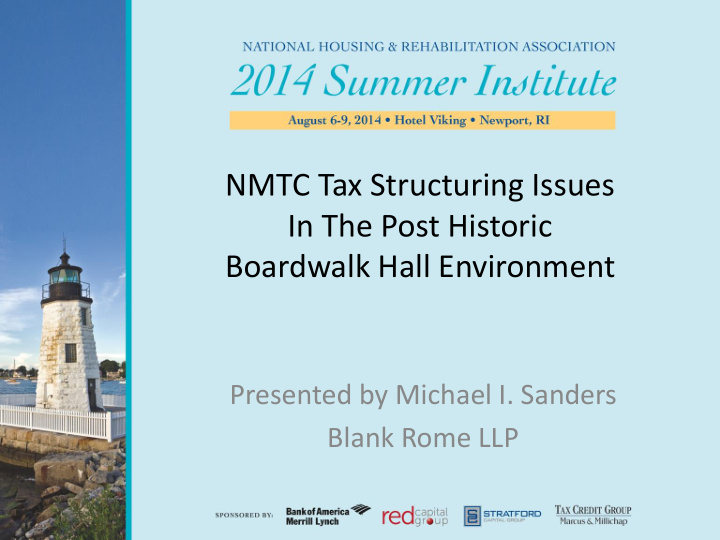



NMTC Tax Structuring Issues In The Post Historic Boardwalk Hall Environment Presented by Michael I. Sanders Blank Rome LLP
TAX OPINION ISSUES: True Debt Considerations – Leverage Loans and QLICIs • It is important that QLICI loans constitute “true debt” for Federal tax purposes. • Under IRC 45D; Reg. Sec. 1.45D-1, equity investment in CDE is a QEI if substantially all (QEI usage) the cash is used to make QLICIs. (QLICI = Capital or Loan to QALICB.) • Stated in Office of Chief Counsel Memorandum dated November 9, 2007 “a loan must be bona- fide debt to be a QLICI.”
• Loans cannot be a grant (counter intuitive considering the purpose of the NMTC program is to provide incentives to development, business in LICs). • What are the ramifications to the CDE of having debt re-characterized as equity? ■ Redemption issues. ■ Related party issues; reasonable expectation test.
• It is important for leverage loans to constitute “true - debt” for federal tax purposes. • What factors are considered in the determination of whether an instrument is “true - debt” for federal tax purposes? ■ Fixed Date of Maturity in the Reasonable Foreseeable Future. ■ The Right to Enforce Payment of Principal and Interest.
■ “Thin” or adequate capitalization. ■ Adequacy of security; creditworthiness of guarantor. ■ Subordination: where an instrument is subordinate to substantially all creditors, indicative of equity. ■ Ability of Borrower to obtain outside credit; would a reasonable creditor provide debt under the same terms.
■ Intent of the parties; a reasonable expectation of repayment that comports with economic reality of the borrower. ■ Source of loan payments; very important. Accounting projections; ability to repay debt – need to look at source of repayment. ■ Participation of Lender in management.
Qualified Active Low-Income Community Business: Non Qualified Financial Property: Construction Safe-Harbor • In general, a qualified active low- income community business (QALICB) includes any corporation (including a nonprofit corporation), partnership, or LLC if with respect to any taxable year less than 5 percent of the average of the aggregate unadjusted basis of the property of such entity is attributable to nonqualified financial property.
• There is a specific rule that provides an exception to the definition of nonqualified financial property relating to the construction of real property, provided that the proceeds of a capital or equity investment or loan by a CDE is expended for construction of real property within 12 months after the date the investment or loan is made; in such a case, the expenditure will be treated as a “reasonable amount of working capital.”
• Many commentators believe that the aforesaid exception is a “safe harbor” rule, although others conclude that the above-described language sets forth a “bright line.” Because the construction of real property often extends well beyond 12 months to perhaps 18 to 24 months – the regulatory language presently is a disincentive to CDEs to make qualified low-income community investments to fund many legitimate projects because the construction period extends beyond the limits.
• If a CDE intends to make a loan to a QALICB involved in the construction of real estate and anticipates that the construction period will exceed 12 months, it generally has two options:
1. The CDE can receive the QEI from their investor, but defer up to 12 months to advance the money to the QALICB. If the cash is retained by the CDE, then the CDE may incur negative interest rate arbitrage by holding the funds at the CDE level and then lending the money to the QLICI over the next 12 months. Furthermore the CDE will incur transaction costs as it makes each disbursement.
2. The investor may make multiple QEIs over a span of 12 to 24 months. If the CDE accepts multiple QEIs, then the CDE may avoid negative interest rate arbitrage by holding the funds at the CDE level, but will incur additional transaction costs with each QEI it receives, in addition to the actual transaction costs as it disburses the funds to the CDE. (However, when the dollars are held in escrow at the QALICB level, they provide added assurance to other lenders and potentially reduce borrowing costs.)
• Pursuant to Treas. Reg. §1.45(D)- 1(d)(4)(iv), a QALICB has 3 years to generate revenue after the investment is made. Such a rule contemplates newly formed businesses and implicitly recognizes that some QALICBs have longer start-up periods, including the real estate construction period with multi-year construction periods.
Recommend
More recommend